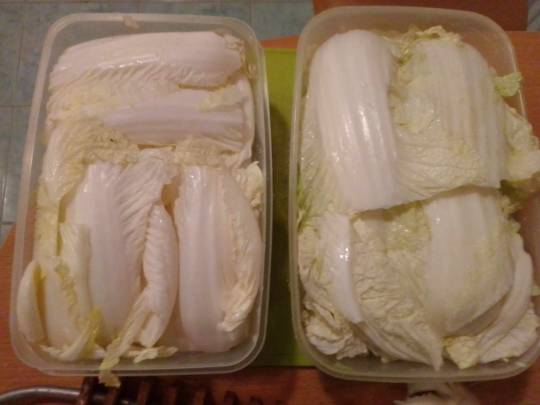#korean kimchi
Text
Side Dishes in Korea
Why do we get served so many each meal?
1. Background Information
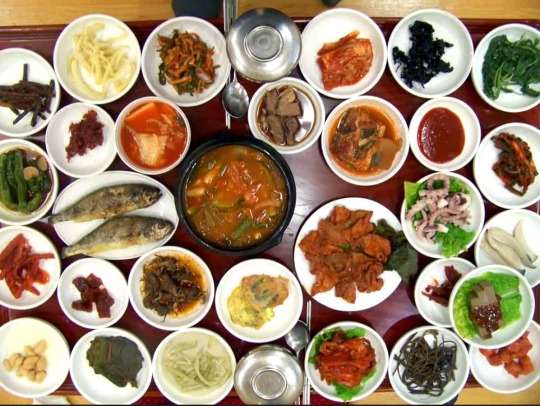
One of the most appealing things about eating out in Korea is the unlimited free refill on the side dishes, known as banchan.
This practice is deeply rooted in Korean history and character as a nation
2. Kimchi

There are hundreds of different types of kimchi, but the signature cabbage banchan is offered at pretty much every restaurant.
Koreans have for generations been storing vegetables in pots to ferment so that they will have food available for the winter.
3. Common Banchans
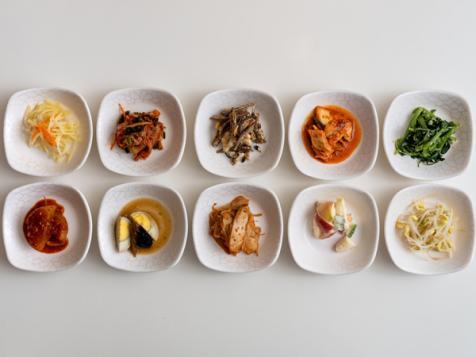
Other than kimchi, there are bean sprouts, cucumber vegetables, and sesame leaves pickled in soy sauce.
Some of the more luxurious Korean restaurant sever egg rolls, tteokbooki, and ganjang gejang.
4. Banchans At Restaurant

Eating at a Korean restaurant is always an exercise in how to maneuver all the dishes to actually fit on the table.
It is not uncommon to receive 3 or more different banchan dishes alongside the main course that you order.
5. Homemade Banchans

During a kimchi-preparation event called kimjang, a large amout of kimchi is laid out for all members of the family work on.
This practice is less common these days, but parents still like to prepare kimchi and distribute it to their children as a show of affection.
6. Why Are Banchan Unlimited?

One reason is that white rice was much more expensive than kimchi and banchan during difficult times in the Korean economy.
It was too expensive for restaurants to give refills of rice, but in order to make sure you were full, they offered you a second helping of banchan.
7. How Is Banchan Served?

In order to reduce operating costs, some restaurants have suggested limiting or removing the unlimited banchan options, which many Korean people weren’t happy about.
To meet in the middle, many Korean restaurants these days have adopted a self-service system in which you can eat as much as you like, but you have to approach the food station and fill your own bowls.
#korean food#korean headers#korean culture#korean banchan#banchan#korea banchan#Korean Guide#Korean lifestyle#korean eats#korean restaurant#korean resources#korean tips#korean vlog#korean blog#korean#korea food#korea guide#korea headers#korean kimchi#korea kimchi#korea lifestyle#korea eats#Korea Republic#korea restaurant#korea resources#korea tip#korea culture#korea vlog#korea blog#korea
162 notes
·
View notes
Text
Fresh Napa cabbage, colorful veggies, and the robust tastes of classic Korean kimchi come together deliciously in the Kimchi Napa Cabbage Salad. A delightful salad that satisfies both modern palates and Korean culinary tradition is produced when crisp textures are combined with the fiery, sour kick of kimchi.
#korean kimchi#making kimchi#kimchi#kimchi ingredients#kimchi korean food#HealthyFood#napa cabbage#Kimchi Recipe#kimchi food
0 notes
Text

Kimchi cats 𓃠⋆.˚✮
8K notes
·
View notes
Photo

Korean Kimchi
Napa cabbage is seasoned with crushed red pepper flakes and fermented in this traditional Korean pickle. 1.5 tablespoons monosodium glutamate, 1 bunch green onions cut into 2 inch pieces, 1/2 cup salt, 3 heads garlic minced, 3 heads napa cabbage cored and cut into quarters lengthwise, 2 teaspoons red pepper flakes or to taste
0 notes
Text
Geotjeori (Fresh Kimchi) By Chef Raphael - H&S Recipe Of The Week
Making Cooking Easy: The Best Of Chef Raphael
For someone new to Korean cuisine, Geotjeori (Fresh Kimchi) is the perfect introduction to a Korean favourite. The process of making kimchi can be time-consuming, including the fermentation stage, and the taste may not appeal to everyone. What I appreciate about this recipe is its simplicity. If you enjoy spice and flavour, you should definitely give…

View On WordPress
#best of Chef Raphael#Bon Appétit#Chef Raphael#cooking#Cooking with Chef Raphael#Food#Fresh Kimchi#Geotjeori#H&S Magazine#H&S Magazine Kenya#Kenya#Kenyan Chef#Kimchi#Kimchi Salad#Korean#Korean cuisine#Korean Kimchi#Magazine#Magazine Kenya#Raphael#Top Kenyan Magazine#top magazine in Kenya
0 notes
Photo
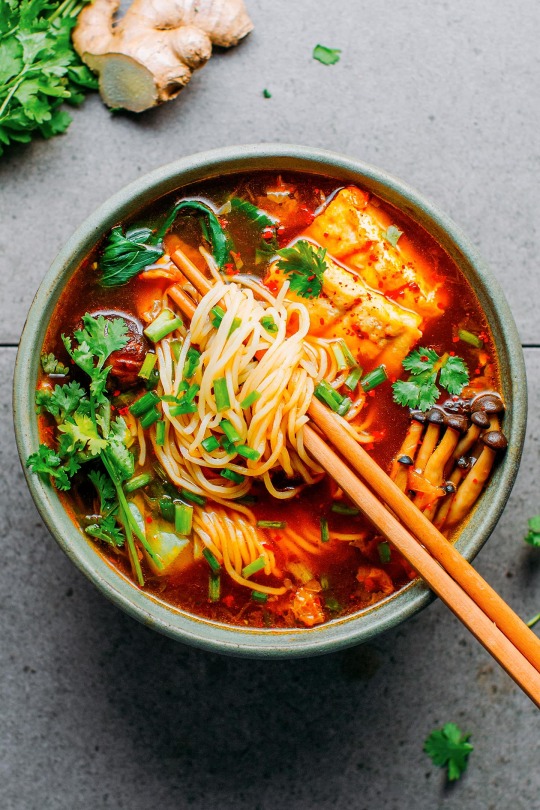
Vegan Kimchi Noodle Soup
3K notes
·
View notes
Text
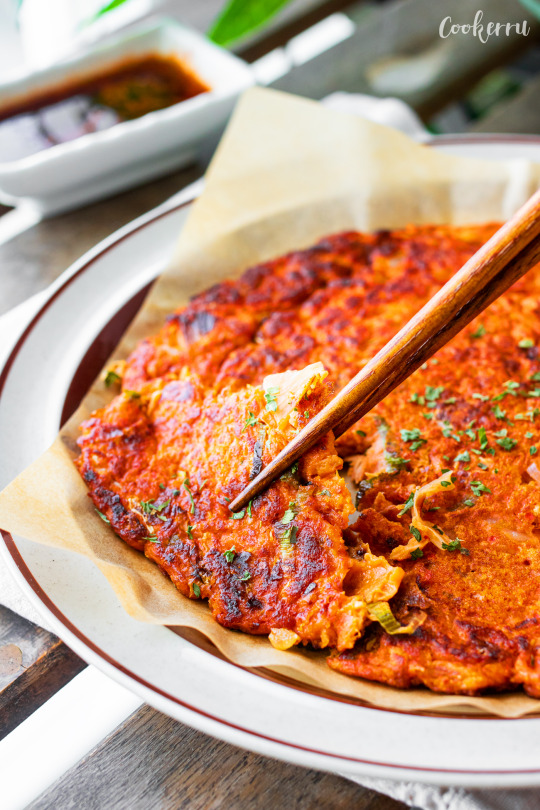
Easy kimchijeon (kimchi pancake)
#kimchi#kimchijeon#pancake#korean food#food#kimchi pancake#asian food#appetizer#spicy#spicy food#vegetarian#dinner#tasty#foodporn#delicious#cooking#food photography#foodgasm#recipe#foodie
424 notes
·
View notes
Text

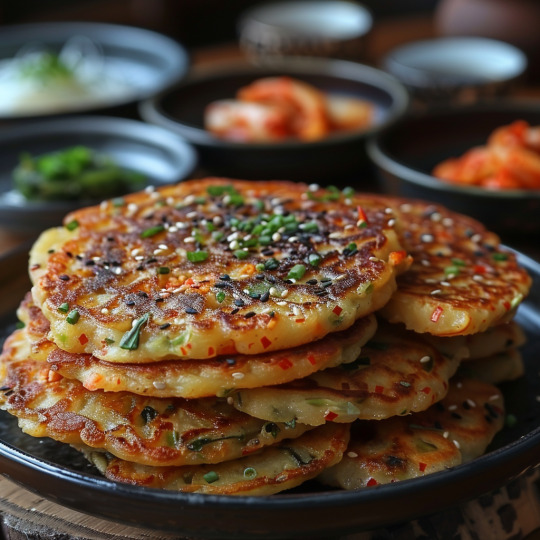
Kimchi Jeon (Savory Kimchi Pancakes)
Yields: 4 servings Prep Time: 15 minutes
Cook Time: 10-15 minutes
Ingredients:
1 cup well-fermented kimchi, roughly chopped
1/4 cup kimchi juice
1/2 cup all-purpose flour
1/4 cup potato or corn starch
1/2 cup cold water
1 large egg, lightly beaten
3-4 scallions, thinly sliced
1-2 tablespoons vegetable oil or neutral-flavored cooking oil
Optional additions:
1 tablespoon gochugaru (Korean red pepper flakes) for extra spice
1 tablespoon soy sauce
1 teaspoon sesame oil
Other vegetables: thin strips of carrot, onion slices
Dipping sauce ingredients:
Soy sauce
Rice vinegar
A pinch of sugar
Toasted sesame seeds (optional)
Instructions:
Make the batter: In a mixing bowl, combine flour, potato/corn starch, kimchi, kimchi juice, egg, water, and scallions. (Include any optional ingredients you'd like). Mix until a slightly thick batter forms.
Heat the pan: Heat a large skillet or nonstick pan over medium heat. Add a thin layer of oil to the pan.
Cook the pancakes: Pour about 1/2 cup of batter into the hot pan, spreading it into a thin, even circle. Cook for 3-4 minutes per side, or until golden brown and crispy.
Repeat: Repeat the cooking process with the remaining batter, adding more oil as needed.
Make the dipping sauce: In a small bowl, combine the soy sauce, rice vinegar, and sugar. Add sesame seeds if desired.
Serve: Slice the pancakes into wedges and serve immediately with the dipping sauce.
Tips:
Well-fermented kimchi: Using older, well-fermented kimchi provides the best flavor and acidity.
Consistency check: The batter should be the consistency of a slightly thick pancake batter. If it's too thick, add a tablespoon or two of water. If it's too thin, add a bit more flour.
Don't overcrowd the pan: Cook one or two pancakes at a time to achieve the best crispiness and an even cook.
Experiment: Feel free to add seafood, thinly sliced pork, or other vegetables to your pancakes.
#korean food#food#homemade#foodshow#food pics#recipe#delicious#food blogs#breakfast#food photography#foodie#daily recipe#daily reminder#daily reaction images#kimchi#korean pancakes#asian food#meal#lunch recipes#dinner ideas
194 notes
·
View notes
Text
"Of South Korea’s countless kilograms of annual food scraps, very few will ever end up in a landfill. This is because of two reasons—the first is that it’s been illegal since 2005, and the second is because they have perhaps the world’s most sophisticated food waste disposal infrastructure.
While representing a significant burden on the economy, the food waste disposal nevertheless produces ample supplies of animal feed, fertilizer, and biogas that heats thousands of homes.
As the New York Times’ John Yoo and Chang Lee reported from Seoul, South Korean cuisine tends to lend itself to creating food scraps, since many staple dishes come with anywhere from a few to a few dozen sides.
With the culture erring on the side of abundance rather than restraint, many of these small dishes of tofu, kimchi, bean sprouts, and other bites would be tossed in the landfill if it wasn’t illegal to do so.
The government put the ban hammer on it because the mountainous terrain isn’t ideal for landfill construction.
Instead, restauranteurs and street hawkers pay the municipality for a sticker that goes on the outside of special bins. Once filled with food scraps, they are left on the road for collectors in the morning who take 90% of all such waste in the country to specialized collection facilities.
At apartments and among residential housing areas, hi-tech food waste disposal machines are operated by a keycard owned by residents under contract with the disposal companies.
Once taken to the recycling facilities, the food is sorted for any non-food waste that’s mixed in, drained of its moisture, and then dried and baked into a black dirt-like material that has a dirt-like smell but which is actually a protein and fiber-rich feed for monogastric animals like chickens or ducks.
This is just one of the ways in which the food scraps are processed. Another method uses giant anaerobic digestors, in which bacteria break down all the food while producing a mixture of CO2 and methane used to heat homes—3,000 in a Seoul suburb called Goyang, for example. All the water needed for this chemical process comes from the moisture separated from the food earlier.
The remaining material is shipped as fertilizer to any farms that need it.
All the water content is sent to purification facilities where it will eventually be discharged into water supplies or streams.
While one such plant was shut down from locals complaining about the unbearable smell, many plants are odorless, thanks to a system of pipes built into the walls that eliminate it via chemical reaction.
It’s the way South Korea does it. Sure, it costs them around $600 million annually, but they have many admirers, including New York City which hopes to implement similar infrastructure in the coming years."
-via Good News Network, June 15, 2023
#south korea#korean food#kimchi#bean sprouts#food waste#landfill#circular economy#sustainability#waste disposal#sanitation#good news#hope#hope posting#new york city#restaurants
495 notes
·
View notes
Text

Kimchi Bibimmyeon
#food#recipe#dinner#bibimmyeon#kimchi#noodles#cucumber#eggs#garlic#gochujang#korean#vegetarian#dairy free
195 notes
·
View notes
Text
Top 5 Korean Food Preferences
1. Blood Sausage - Salt or Sauce

Sundae is one of Korea’s popular street food. Most Koreans in Seoul eat blood sausages by dipping them into salt. Meanwhile, people in Jeolla-do like to dip in red pepper paste with vinegar and those from Gyeongsang-do dip it into makjang, a sauce combination of red pepper paste, garlic, sugar, and other spices.
2. Korean-Chinese Food - Jjajangmyeon or jjampong
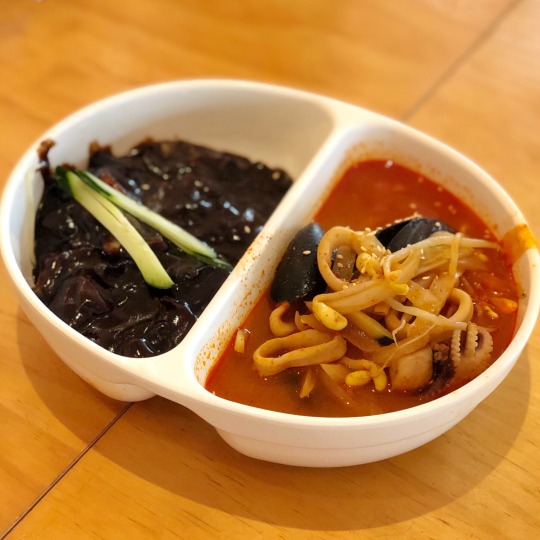
These are the two main dishes in Korean-Chinese restaurants jjajangmyeon is black bean noodles and jjampong is seafood noodles soup. Everyone who goes to a Korean-Chinese restaurant will always have the one dish between these two that they always order without changing.
3. Fried Chicken - Original or Marinated

This is another super popular food in South Korea, with these both flavors being widely loved by everyone. Many people are always not sure which flavor to go for. Because of that, many restaurants already have a half-half option for their customers now.
4. Kimchi - Fresh or Ripened

There are so many different kinds of Kimchi, and even more ways to enjoy it. People in Seoul usually have Kimchi that is less salty while people in Gyeongsang-do have it more spicy. Fresh Kimchi is usually preferred as a side dish, while the ripened one are used more for cooking.
5. Soju - Chamyiseul or Cheoum cheoreom

Soju is the most common alcohol that Korean consume with it sometimes being cheaper than soda at restaurants. Chamyiseul is the top-selling brand in Korea as many people says that it has a sweeter taste. On the other hand, many enjoy Cheoum Cheoreom as it has lower alcohol content.
#Korean food#Korean fried chicken#korean kimchi#korea kimchi#south korea kimchi#korean guide#korean headers#korean soju#korea soju#south korea soju#korean eats#korean restaurant#korean tips#korean cuisine#korean vlog#Korean culture#korean blog#korean#korean moodboard#korea drinks#korean drinks#korea food#korea facts#korean facts#korea guide#korea headers#korea eats#Korea Republic#korea restaurant#korea tips
5 notes
·
View notes
Text






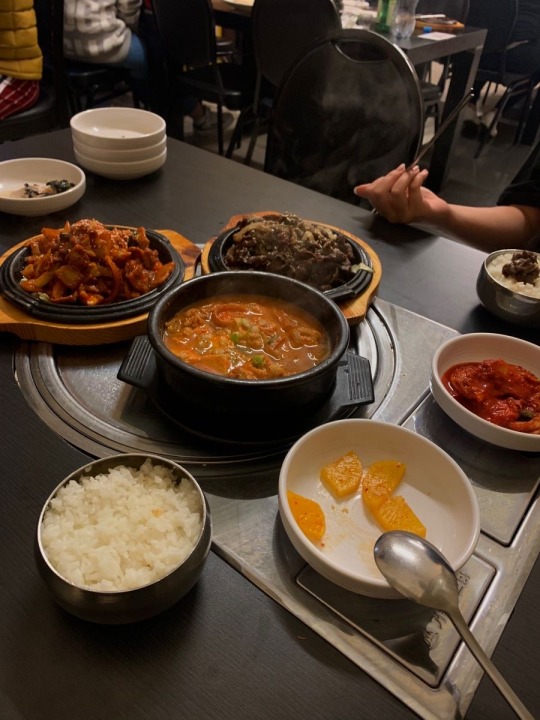
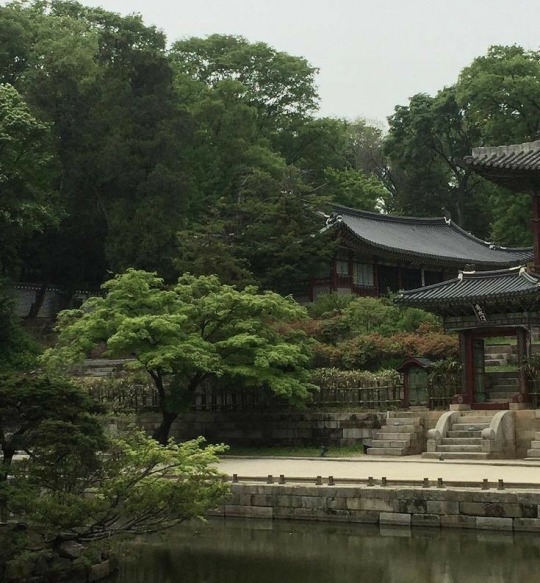


𝘔𝘦𝘯𝘵𝘢𝘭𝘭𝘺 𝘐’𝘮 𝘩𝘦𝘳𝘦 𝘸𝘪𝘵𝘩 𝘩𝘦𝘳 𝘢𝘨𝘢𝘪𝘯 🍊
Dear, M.
#busan south korea#vogue korea#south korea#korean#Korea#South Korea aesthetic#travel#Asia#travel aesthetic#South Korea travel#academia#chaotic academia#classic academia#dark academia#literature#aesthetic#english literature#uni#college#her#i miss them#I miss her#persimmon#Busan#Seoul#Daegu#kimchi#sunset#korean bbq#dear m.
64 notes
·
View notes
Text
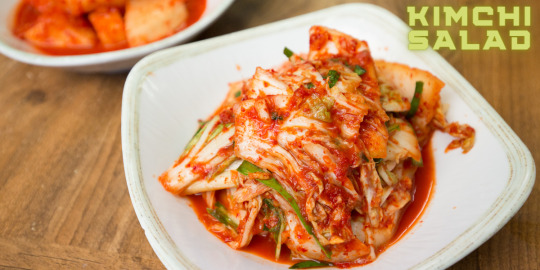

Korean Kimchi Food
Once and for all, A tasty and colorful food that not only attracts the taste senses but may also help with weight loss, kimchi stands out in the world of savory and nutritious foods. This fermented delicacy, which originated in Korea, has become a global favorite and is a staple in Korean cuisine.
#kimchi probiotic#korean kimchi#radish kimchi#making kimchi#napa kimchi#kimchi#kimchi ingredients#kimchi korean food#napa cabbage#fermented kimchi#kimchi food#kimchi vegetables
0 notes
Text

Cheesy Kimchi Crispy Rice Paper Dumplings
#veganbunnychef#sides#food#recipe#recipes#savoury#cheese#cheesy#kimchi#dumplings#rice paper#rice paper dumplings#mozzarella#cheddar#gochujang#korean#tasty#delicious#foodporn#food porn#foodphotography#food photography
206 notes
·
View notes
Text
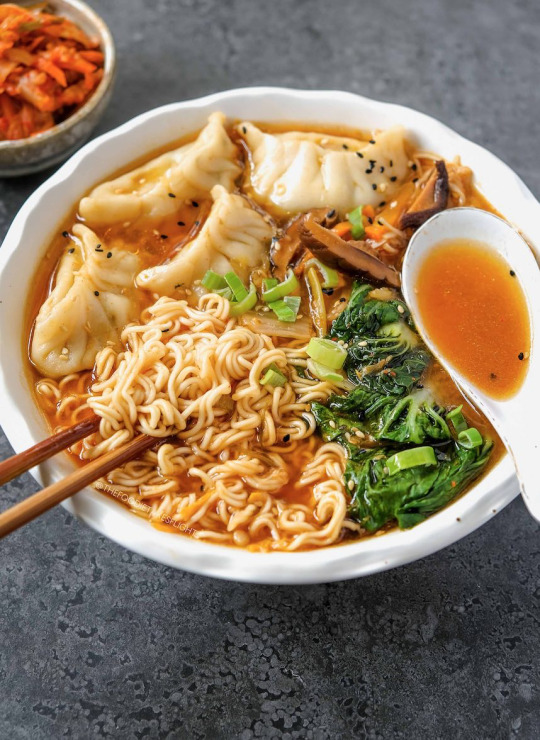
Vegan Kimchi and Dumpling Noodle Soup
#vegan#lunch#dinner#korean cuisine#East Asian cuisine#soups#noodles#kimchi#dumplings#mushrooms#miso#gochujang#garlic#sesame oil#bok choy#sesame seeds#green onion
82 notes
·
View notes
